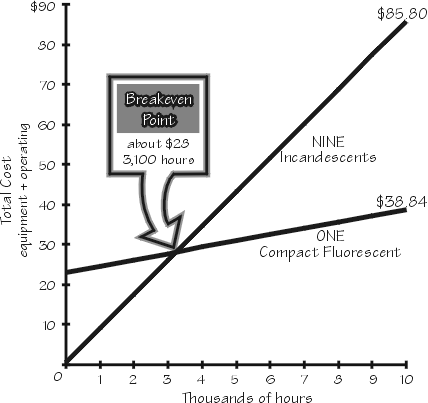
 |
The New Independent Home
by Michael Potts

from chapter 1 :
Sticker Shock and Whole Cost |
Energy-consuming products, from light bulbs and clock radios to refrigerators and automobiles, usually cost more to operate over their lifetime than they do to buy, and so purchase price is a deceptive yardstick. Suppose you are an apartment dweller whose electricity payments are included in your monthly rent. Would it be foolish to buy a light source that will outlast your intended stay? Here the "true cost" reckoning is complicated by hidden social costs. If you can demonstrate to the landlord a pattern of reduced electrical costs, might he not offer a rent reduction? Might you be wiser to separate utilities from rent, so that any economies might accrue directly to you, the economizer? The landlord stands, in this case, for society: By burning fewer kilowatts to generate the light we need, thereby reducing energy consumption, slowing the race to exploit energy sources, and decreasing emissions associated with their extraction and incineration, we benefit humanity. Even though a cost may be concealed, it is still real, and somewhere, someone pays. There is still no free lunch.
As the distance between original source and manufacturer and consumer stretches, some of the real costs disappear into the infrastructure of modern life. In some cases, these deferred costs are greater than what we pay for an item; for an extreme example, could the people of the Ukraine add enough to the price of their electricity to pay for the clean-up of Chernobyl? especially considering that the long-term effects of the Chernobyl disaster are global and incalculable?
There are at least two factors in the whole cost of any item: the cost to buy it (equipment cost), and the cost to maintain it (operating cost). To those costs, we should in most cases add two more: the true cost to create it, and the true cost to dispose of it at the end of its useful life. Both of these are usually absorbed by the environment or borne by the society in hidden ways. The accompanying sidebar may illuminate this idea.
sidebar: Whole-Life Cost Analysis
[[photo: lightbulb and compact fluorescent]]
|
hours
 |
incandescent
 |
CF
 |
| 0 |
$0.60 |
$23.00 |
| 1,000 |
$9.12 |
$24.58 |
| 2,000 |
$17.64 |
$26.17 |
| 3,000 |
$26.16 |
$27.75 |
| 4,000 |
$34.68 |
$29.34 |
| 5,000 |
$43.20 |
$30.92 |
| 6,000 |
$51.72 |
$32.50 |
| 7,000 |
$60.24 |
$34.09 |
| 8,000 |
$68.76 |
$35.67 |
| 9,000 |
$77.28 |
$37.26 |
| 10,000 |
$85.80 |
$38.84 |

|
|
Start with a simple whole-life, cradle-to-cradle cost comparison: in this corner, the champion and most-favored light source, the incandescent bulb. In that corner, the challenger, a first-generation compact fluorescent (CF) lamp. Considering only the standard economic consideration, equipment cost, the champion wins the first round easily: Who would buy a light for $25 when you can buy a package of four equally bright champs for under $3? But wait! the cheaper bulb lasts only 1,100 hours, one ninth as long as the challenger, and more than two packages of four are required to compare fairly, so the challenger appears to be four times as expensive past the checkout counter. If you mean to buy light with only three dollars in your pocket, study no more: initial equipment cost decides the contest. For the longer, whole-life view, look again! The CF package bears a startling claim: the new-fangled light source consumes only a quarter of the electricity drawn by the conventional bulb. Doesn't someone pay for all that extra electricity? Over the whole life of the competing lights, which costs more? Assuming that electricity and lightbulbs will not increase in price -- an exceedingly unlikely assumption -- incandescent bulbs (it will take about nine) will use so much more energy over the lifespan of the compact fluorescent that the champion's overall equipment plus operating cost will be almost twice (188%) the challenger's. CF costs are dropping while incandescents are going up slowly, but judging by recent energy trends, a ten percent annual increase in operating cost is reasonable, and the champ's whole-life cost may approach two-and-a-half times (236%) the challenger's by the time the CF burns out.
|
Want to do the math
for your $AVING$?
|

|